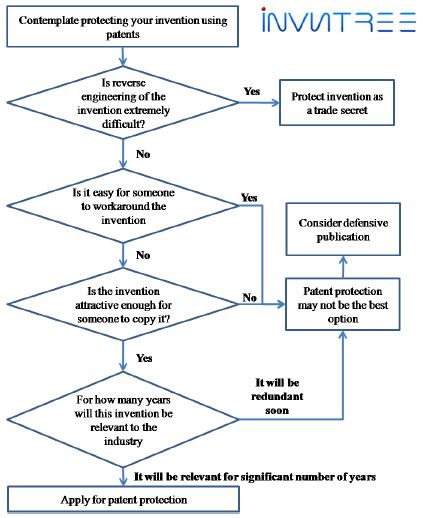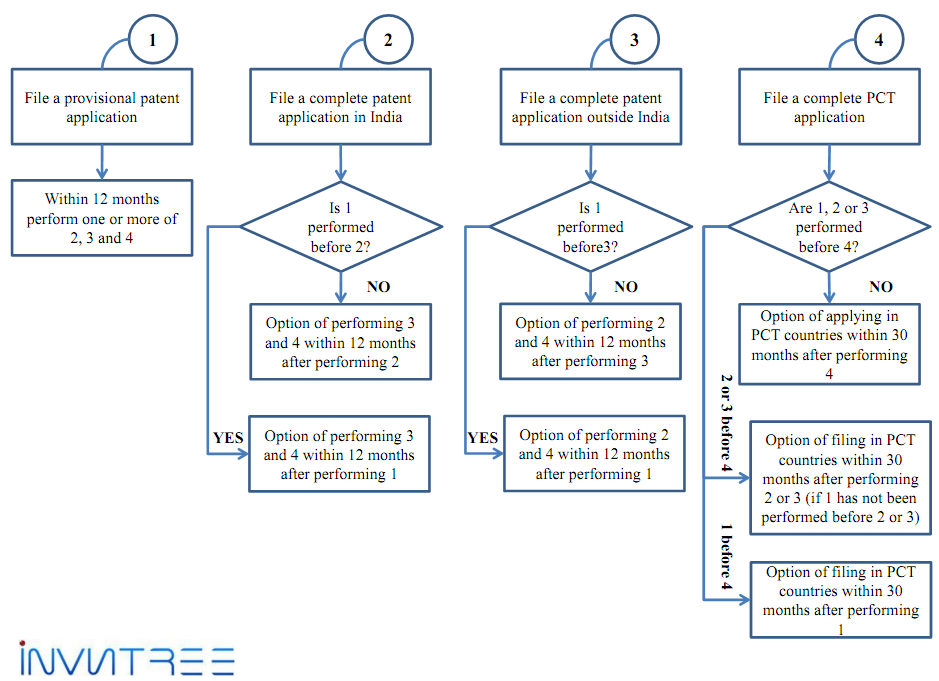Tag Archives: patent filing
Are patents always the best way to protect inventions?
To answer this question, let us first look at the bright side of patent. If you have a patent granted from your invention, it gives you the rights to exclude others from commercializing your patented technology for 20 years in the country in which it is granted. In other words, it means, you enjoy monopoly over the patented technology for 20 years in the country in which it is granted.
- On an average, it takes ~47 months (identified using a sample of 3191 US patents granted in the year 2011) from the date of filing a patent application to get a patent granted. Patenting is a time consuming process.
- Patents are territorial. This means, you will have to file patent applications in each country in which you want to protect your invention.
- You will have to pay a statutory fee to the patent office in each country you file a patent application. Additionally, you will also have to pay the patent consultant who helps you with filing the patent application in the respective country (we once received a quote of $2000 from a Japanese attorney for filing a patent application in Japan). In a nutshell, patenting is an expensive process.
Irrespective of all these hurdles, individuals and companies file for patents. In certain circumstances, it makes perfect sense to protect your inventions using patents. However, in my opinion, you should ask yourself some questions before you decide to protect your invention using patents.
- How easily can my invention be reverse engineered?
- How easy is it for someone to work around the invention and achieve the advantages provided by the invention?
- Is the invention attractive enough for someone to copy it?
- For how many years will this invention be relevant to the industry?
What are the different patent filing options?
In simple words, “Patent filing” can be defined as a process of submitting an application in a patent office requesting grant of patent to your invention. If you wish to protect your invention in different countries, then you will have to submit a patent application in each of those countries. There are various options or approaches you may use to protect your invention in one or more countries. By understanding the various patent filing options, you can construct a patent filing strategy based on your business objectives and economic constraints. This articles attempts to provide an overview of the patent filing options you can use. (You may be also interested in reading the article “How much does it cost to get a patent in India”)
Please note that, the most important factor in filing a patent application is preparing a patent specification. Drafting a patent specification is a highly skilled job, which can be only preformed by persons who have both techinical as well as patent law expertise. If a person or company is serious about protecting their intellectual property, it is highly recommeded to use the services of professional patent practitioners. To know more about this, you can read our article on this here.
-
Filing a provisional patent application
-
Filing a complete patent application in your country
-
Filing a patent application in a foreign country
-
Filing a Patent Cooperation Treaty (PCT) application
A provisional patent application is filed to secure a priority date for your invention. A priority date is the date on which the first patent application for your invention is filed. This date is important because, knowledge available in public domain before the priority date is referred to as “prior art”, and this prior art is considered by the patent office to decide if a patent has to be granted to your invention. If you delay filing of the patent application, then naturally, more knowledge in the public domain gets added to the prior art, hence decreasing the probability of patent grant to your invention.
Normally, inventors/companies file a provisional application in two scenario. The first scenario is when time is of concern, and drafting a well constructed complete patent specification might delay the patent filing process. This delay in filing, pushes the priority date further, thereby reducing the probability of patent grant to your invention. The second scenario is when money is of concern. Depending on the country in which the patent application is filed, there can be a substantial difference between the provisional and complete application fee that has to be paid to the patent office. Further, depending on the patent consultant you choose to work with, there can be substantial difference in the fee charged by the patent consultant to draft a provisional and a complete specification. Hence, sometimes inventors/companies draft a provisional specification on their own and file the same.
A complete patent application has to be filed in the patent office of your country if you wish to protect your invention in your country. A complete patent application can be filed in the first place or if you have filed a provisional application provisously, then within 12 months from the provisional application filing date.
-
File a provisional application in any convention country (secure a priority date) and file a complete application in the patent office of your country within 12 months from the priorit date.
-
File a complete application in any convention country (secure a priority date) and and file a complete application in the patent office of your country within 12 months from the priority date.
-
Use the PCT route – Explained under option 4
-
File a provisional application in any convention country (secure a priority date) and file a complete application in each of the foreign countries in which you wish to protect your invention within 12 months from the priorit date.
-
File a complete application in any convention country (secure a priority date) and file a complete application in each of the foreign countries in which you wish to protect your invention within 12 months from the priority date.
-
Use the PCT route – Explained in detail below
-
File a provisional application in any PCT member country (secure a priority date) and file a PCT aspplication within 12 months from the priorit date. Subsequently, file patent applications, within 30/31 months from priority date, in each country (has to be a PCT member country, list of PCT contracting countries) you wish to protect your invention.
-
File a complete application in any PCT member country (secure a priority date) and file a PCT application within 12 months from the priority date. Thereafter, file patent applications, within 30/31 months from priority date, in each country (PCT member country) you wish to protect your invention.
-
File a PCT application in the first place and secure a priority date. Thereafter, file patent applications, within 30/31 months from priority date, in each country (PCT member country) you wish to protect your invention.
You may be interested in reading our other related articles listed below:
What can be patented and what cannot be patented
Some time back I was asked by one of the readers of my article, if I can tell him what can be patented and what cannot be; hence this article.
1. an invention which is frivolous or which claims anything obviously contrary to well – established natural laws: (Ex:
4 fold approach to using patents for improving business competitiveness
Introduction
- A patentee gets the liberty to enjoy monopoly over the patented invention for 20 years
- A patentee can monetize his patented invention by selling or licensing out his rights, in addition to other ways of monetizing
- Engineers and scientists can access a rich pool of patent information and improvise on existing technology
- Competitors will have to create non-infringing products and processes
One of the approaches for improving competitiveness of a business is by having product differentiators. Product differentiators are brought about by developing products that are technologically superior, has newer/better features or addresses specific needs of customers. Sometimes, there might not be any changes made to the product, however, companies might differentiate themselves from competition by offering products at reduced prices. This might be possible by making changes to the processes used in producing the product. Such modifications made to the products/processes might be patent worthy. Hence, when a company feels that they have made some modification that might be patent worthy, it is important to contemplate the idea of having such improvements protected by a patent.
You may go through our articles to know more about filing patent applications in India and the cost of filing patent applications in India.
- Patent Application Filing Procedure/Process in India
- How much does it cost to get a patent in India?
Patents to Improve Competitiveness – InvnTree IP Services
- Create an entry barrier for competitors
- Maintain product or process differentiators
- Protect products or processes from being copied by competitors
- Enjoy monopoly over improvements for 20 years
- Increase valuation of the company
The previous approach dealt with protecting technological improvements made by a company. While, the previous approach dealt with building a patent fortress to safeguard ones business territory, it is equally important to monitor the patent fortress’ built by competitors.
- Ensure against obvious improvements being protected by competitors
- Enhance the valuation of patents held by you in a technology field
- Avoid being sued for infringing patents that shouldn’t have been granted in the first place
- Easy access to freely use and adopt minor improvements in technology
Respect others intellectual property
In the previous two approaches, we dealt with building a patent fortress and ensuring that competitors do not strengthen their patent fortress using minuscule technological improvements. In the current approach we illustrate why it is important to respects others Intellectual Property rights.
- Ensure against introducing infringing products to the market
- Avoid expensive patent infringement suits
- Ensure that brand name is not tarnished by such infringement
To know more about respecting others intellectual property, you may read our articles listed below:
- Why is freedom to operate study a must for technology companies?
- 5 options available if your product is infringing on a patent
- Is my product infringing on others patents?
Remember, no one got too far by reinventing the wheel, neither will you; hence, there is no point in reinventing the wheel. It is important to appreciate the fact that most of the problems that we might be trying to solve, might have been solved by somebody else in some part of the world. Therefore, it will be intelligent on your part to look at such solutions and improvise on them. Patent data is considered to be the richest source of scientific information, and using this information is an intelligent approach to product and process development.
- Enhanced returns on investment in R&D
- Development of products/processes that have improvised on existing technology
- Reduced cost of development of product/process
- etter business forecasting and planning
We hope you found this article helpful. You can download a copy of this article here
Please feel free to contact us for any information that you may need.

 Follow
Follow



